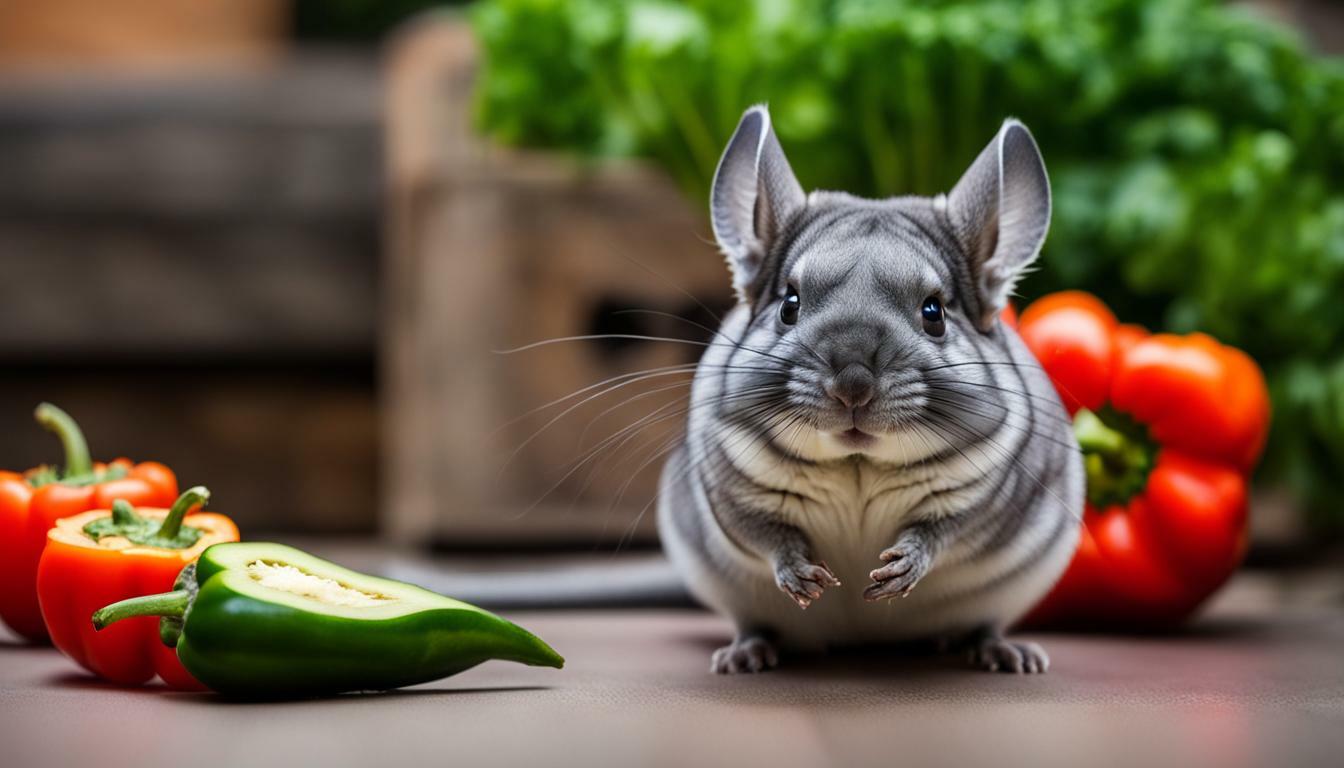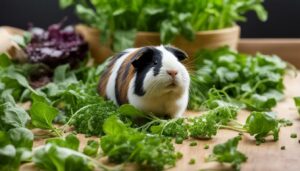Chinchillas are adorable pets, but it’s essential to know what foods are safe for them to eat. One common question owners have is whether chinchillas can enjoy bell peppers.
Key Takeaways:
- Bell peppers can be fed to chinchillas in small amounts as an occasional treat
- They are low in calories and contain vitamins and minerals
- Red bell peppers are the most nutritious, followed by orange and yellow
- Green bell peppers have fewer nutrients
- Bell peppers should be given in moderation to prevent digestive issues and obesity
- Limit the amount of bell pepper to a small piece the size of a fingernail, once or twice a week
- Other vegetables that chinchillas can safely eat include carrots, kale, alfalfa, celery, potato, sweet potatoes, and squash
- Avoid feeding chinchillas spicy or pickled peppers
- Provide a balanced diet consisting mainly of hay, supplemented with pellets, fresh greens, and occasional treats
Nutritional Benefits of Bell Peppers for Chinchillas
Bell peppers can offer some nutritional benefits to chinchillas due to their low-calorie content and the vitamins and minerals they contain. These colorful vegetables are packed with nutrients that can support your chinchilla’s overall health.
Firstly, bell peppers are low in calories, making them a great option for chinchillas who need to maintain a healthy weight. They are also high in vitamin C, which is essential for boosting your pet’s immune system and promoting healthy skin and fur.
In addition to vitamin C, bell peppers contain vitamin A, which is important for chinchillas’ eyesight and reproductive health. These peppers also provide minerals such as potassium and magnesium, which play a crucial role in maintaining proper bodily functions of your furry friend.
When offering bell peppers to your chinchilla, it’s important to do so in moderation. While they provide nutritional benefits, they also contain water and sugar, which can lead to digestive issues and obesity if consumed excessively. It is recommended to limit the amount of bell pepper given to a chinchilla to a small piece the size of a fingernail, once or twice a week.
| Benefits of Bell Peppers for Chinchillas: |
|---|
| Low in calories |
| High in vitamin C |
| Contains vitamin A |
| Provides minerals like potassium and magnesium |
Aside from bell peppers, there are other vegetables that chinchillas can safely consume. Carrots, kale, alfalfa, celery, potato, sweet potatoes, and squash are just a few examples. However, it’s important to avoid feeding chinchillas spicy or pickled peppers, as these can be harmful to their digestive system.
A balanced diet for your chinchilla should mainly consist of hay, supplemented with high-quality pellets and small amounts of fresh greens and occasional treats. Providing a variety of vegetables, including bell peppers in moderation, can help ensure your chinchilla receives the necessary nutrients for a healthy and happy life.
Moderation is Key: How Many Bell Peppers Can Chinchillas Eat?
While bell peppers are safe for chinchillas to eat, it’s crucial to offer them in moderation to avoid digestive issues and obesity. Bell peppers contain water and sugar, which can lead to gastrointestinal problems if given in excessive amounts. It’s recommended to limit the amount of pepper given to a chinchilla to a small piece the size of a fingernail, once or twice a week.
In addition to their size, the color of the bell pepper also plays a role in how much a chinchilla can consume. Red bell peppers contain the most nutrients, followed by orange and yellow, while green bell peppers have fewer nutrients. While all colors are safe for chinchillas, it’s important to remember that the nutritional value varies.
To provide a balanced diet, chinchillas should not solely rely on bell peppers as their main source of nutrition. Other vegetables that are safe for chinchillas to eat include carrots, kale, alfalfa, celery, potato, sweet potatoes, and squash. These vegetables can be given in small amounts, along with a diet that mainly consists of hay, supplemented with pellets, fresh greens, and occasional treats.
| Color of Bell Pepper | Nutritional Value |
|---|---|
| Red | Contains the most nutrients |
| Orange and Yellow | Contain moderate levels of nutrients |
| Green | Contains fewer nutrients |
In conclusion, chinchillas can enjoy bell peppers as an occasional treat, but it’s important to practice moderation. Offering a variety of vegetables, including bell peppers, along with a balanced diet of hay, pellets, and fresh greens, will help ensure that your chinchilla receives the appropriate nutrition for optimal health.
The Nutritional Differences Between Red, Orange, Yellow, and Green Bell Peppers
Did you know that the color of a bell pepper can indicate its nutritional content? Red bell peppers are the most nutritious, followed by orange and yellow, while green bell peppers have fewer nutrients. Let’s take a closer look at the nutritional differences between these colorful veggies and how they can benefit your chinchilla’s diet.
Red Bell Peppers: These vibrant peppers are packed with vitamins and minerals, making them a great choice for your chinchilla. Red bell peppers are rich in vitamin C, which is essential for a healthy immune system and can help prevent illness. They also contain vitamin A, which promotes good vision, and vitamin B6, which supports brain function. Additionally, red bell peppers provide antioxidants that can help protect your chinchilla’s cells from damage.
Orange and Yellow Bell Peppers: Like their red counterparts, orange and yellow bell peppers are also good sources of vitamins and minerals. They contain vitamin C, vitamin A, and vitamin B6, although in slightly lower amounts compared to red bell peppers. These peppers are also high in antioxidants and can contribute to your chinchilla’s overall well-being.
Green Bell Peppers: Although green bell peppers have a milder taste, they are still a nutritious option for your chinchilla. While they have fewer vitamins and minerals compared to red, orange, and yellow peppers, they still contain some vitamin C and vitamin A. Including a small amount of green bell pepper in your chinchilla’s diet can provide variety and additional nutrients.
| Bell Pepper Color | Vitamin C (mg per 100g) | Vitamin A (IU per 100g) | Vitamin B6 (mg per 100g) |
|---|---|---|---|
| Red | 127.7 | 3701 | 0.3 |
| Orange | 115 | 2250 | 0.2 |
| Yellow | 183 | 2007 | 0.2 |
| Green | 80.4 | 1057 | 0.2 |
Remember, while bell peppers can provide nutritional benefits to your chinchilla, it’s essential to feed them in moderation. Too much pepper, regardless of color, can cause digestive issues and contribute to obesity. Offer a small piece the size of a fingernail once or twice a week as a treat. And don’t forget to provide a balanced diet for your chinchilla that mainly consists of hay, supplemented with pellets and small amounts of fresh greens.
Other vegetables that chinchillas can safely enjoy include carrots, kale, alfalfa, celery, potato, sweet potatoes, and squash. Just like with bell peppers, it’s important to introduce these vegetables gradually and in small amounts to avoid upsetting your chinchilla’s digestive system. Remember, variety is key when it comes to providing a nutritious and enjoyable diet for your furry friend!
Other Vegetables Chinchillas Can Eat
In addition to bell peppers, chinchillas can enjoy a variety of other vegetables that provide essential nutrients. These vegetables can be a great addition to your chinchilla’s diet, offering both variety and important vitamins. Remember to introduce new vegetables gradually and monitor your chinchilla’s reaction to ensure they tolerate them well.
Here are some vegetables that chinchillas can safely consume:
- Carrots: Carrots are a crunchy and sweet vegetable that chinchillas love. They are high in vitamin A and provide a good source of fiber.
- Kale: Kale is a leafy green vegetable that is rich in vitamins A, C, and K. However, it should be given in moderation because of its high calcium content.
- Alfalfa: Alfalfa is a legume that provides a good source of protein, fiber, and calcium. Chinchillas enjoy its taste and texture.
- Celery: Celery is a low-calorie vegetable that is safe for chinchillas. It is high in water content and can help keep your chinchilla hydrated.
- Potato and Sweet Potatoes: These root vegetables can be offered in small quantities. They are a good source of carbohydrates and can add variety to your chinchilla’s diet.
- Squash: Squash is a hydrating vegetable that chinchillas can enjoy. It is packed with vitamins and minerals, making it a healthy option.
While offering these vegetables to your chinchilla, it’s important to remember that they should only make up a small portion of their overall diet. The main component of a chinchilla’s diet should be high-quality hay, which provides essential fiber for their digestive system. Pellets can also be provided as a source of additional nutrients, but they should be given in moderation to prevent obesity.
Remember to always consult with a veterinarian about your chinchilla’s diet and any specific dietary needs they may have. In addition to a balanced diet, chinchillas should have access to fresh water at all times and be given occasional treats to provide mental stimulation and variety.
| Vegetable | Nutritional Benefits |
|---|---|
| Carrots | High in vitamin A and fiber |
| Kale | Rich in vitamins A, C, and K |
| Alfalfa | Good source of protein, fiber, and calcium |
| Celery | Low-calorie and hydrating |
| Potato and Sweet Potatoes | Provide carbohydrates and variety |
| Squash | Hydrating and packed with vitamins and minerals |
Foods to Avoid: Spicy and Pickled Peppers
While chinchillas can enjoy bell peppers, it’s important to avoid feeding them spicy or pickled peppers, as they can be harmful to their health. Spicy peppers, such as jalapenos or chili peppers, contain a compound called capsaicin, which can cause irritation and digestive upset in chinchillas. Pickled peppers, on the other hand, are often high in salt and vinegar, both of which are not suitable for a chinchilla’s diet.
Spicy peppers can cause discomfort and gastrointestinal issues in chinchillas, such as diarrhea or stomach pain. Chinchillas have sensitive digestive systems, and foods high in capsaicin can disrupt their natural balance. Pickled peppers, with their high salt and vinegar content, can also lead to dehydration and imbalances in their electrolyte levels.
To ensure the well-being of your chinchilla, it’s crucial to provide a diet that consists of foods that are safe and appropriate for their specific needs. Stick to feeding them small amounts of fresh, raw bell peppers instead, as these provide nutritional benefits without the risk of digestive issues. Remember to always wash the bell peppers thoroughly to remove any pesticides or other harmful substances before offering them to your furry friend.
| Foods to Avoid | Reason |
|---|---|
| Spicy Peppers | Contain capsaicin, which can cause digestive upset and irritation |
| Pickled Peppers | High in salt and vinegar, which can lead to dehydration and imbalances |
Remember, chinchillas have specific dietary requirements, and it’s essential to provide them with a balanced diet that mainly consists of hay, supplemented with pellets and small amounts of fresh greens. Treats, such as bell peppers, should only be given in moderation. It’s also important to offer a variety of vegetables to ensure they receive a wide range of nutrients. Carrots, kale, alfalfa, celery, potato, sweet potatoes, and squash are among the other vegetables that chinchillas can safely consume.
By being mindful of what foods to avoid and providing a well-rounded diet, you can ensure your chinchilla stays healthy, happy, and content.
Creating a Balanced Diet for Your Chinchilla
To keep your chinchilla healthy, it’s crucial to provide them with a balanced diet that includes various components. This means ensuring they have a steady supply of fresh hay, as this is the foundation of their diet. Hay helps maintain their dental health and aids in digestion. Choose high-quality grass hay, such as Timothy or Orchard grass, and make sure it is always available in their enclosure.
In addition to hay, chinchillas also benefit from a small portion of pellets specifically formulated for their nutritional needs. Pellets provide essential vitamins and minerals that may be lacking in their hay. However, it’s important not to overfeed pellets, as chinchillas can easily become overweight. Follow the recommended serving size based on your chinchilla’s weight and monitor their weight regularly.
While hay and pellets form the basis of a chinchilla’s diet, they can also enjoy small amounts of fresh greens and vegetables as treats. These should be given in moderation to avoid digestive issues. Carrots, kale, alfalfa, celery, potato, sweet potatoes, and squash are safe options that can be offered occasionally. Remember to introduce any new food gradually, as chinchillas have sensitive digestive systems.
| Food | Portion Size | Frequency |
|---|---|---|
| Hay | Unlimited | Daily |
| Pellets | 1-2 tablespoons | Daily |
| Vegetables | Small piece the size of a fingernail | Once or twice a week |
It’s important to note that chinchillas have sensitive digestive systems and should not be fed foods that are high in sugar, fat, or spices. Avoid giving them human food, as it may contain ingredients that are harmful to them. Additionally, always provide fresh water in a sipper bottle, and clean both the bottle and food dishes regularly.
By maintaining a balanced diet for your chinchilla, you can ensure they receive the necessary nutrients for optimal health. Remember to consult with a veterinarian specializing in exotic pets if you have any concerns or questions about your chinchilla’s diet.
Conclusion
In conclusion, chinchillas can enjoy bell peppers in small amounts as an occasional treat, as long as they are introduced in moderation and part of a balanced diet. Bell peppers are not toxic to chinchillas and can provide some nutritional benefits. They are low in calories and contain vitamins and minerals that are important for their overall health.
However, it’s crucial to remember that bell peppers also contain water and sugar, which can cause digestive issues and obesity if consumed in excess. Therefore, it’s recommended to limit the amount of pepper given to a chinchilla to a small piece the size of a fingernail, once or twice a week.
When choosing bell peppers for your chinchilla, opt for the red variety as they contain the most nutrients. Orange and yellow bell peppers are also good choices, while green bell peppers have fewer nutrients. Remember to wash the peppers thoroughly before feeding them to your chinchilla to remove any pesticides or dirt.
In addition to bell peppers, there are other vegetables that chinchillas can safely consume. Carrots, kale, alfalfa, celery, potato, sweet potatoes, and squash are some examples of vegetables that can be included in their diet. However, it’s important to introduce new foods gradually and in small quantities to avoid digestive upset.
It’s crucial to avoid feeding chinchillas spicy or pickled peppers, as these can be harmful to their digestive system. Additionally, it’s essential to provide a balanced diet for your chinchilla, primarily consisting of hay, supplemented with pellets and small amounts of fresh greens. Treats should be given sparingly to prevent dietary imbalances.
By following these guidelines and ensuring a well-rounded diet, you can safely incorporate bell peppers and other vegetables into your chinchilla’s nutrition, promoting their overall health and well-being.
FAQ
Can chinchillas eat bell peppers?
Yes, chinchillas can eat bell peppers in small amounts as an occasional treat.
What are the nutritional benefits of bell peppers for chinchillas?
Bell peppers are low in calories and contain vitamins and minerals that can benefit chinchillas.
How many bell peppers can chinchillas eat?
It is important to feed bell peppers to chinchillas in moderation, limiting the amount to a small piece the size of a fingernail, once or twice a week.
Are there nutritional differences between different colored bell peppers?
Yes, red bell peppers contain the most nutrients, followed by orange and yellow, while green bell peppers have fewer nutrients.
What are some other vegetables that chinchillas can eat?
Chinchillas can also eat carrots, kale, alfalfa, celery, potato, sweet potatoes, and squash.
Can chinchillas eat spicy or pickled peppers?
No, it is important to avoid feeding chinchillas spicy or pickled peppers as they are not suitable for their consumption.
How can I create a balanced diet for my chinchilla?
A balanced diet for a chinchilla should mainly consist of hay, supplemented with pellets, small amounts of fresh greens, and occasional treats.




